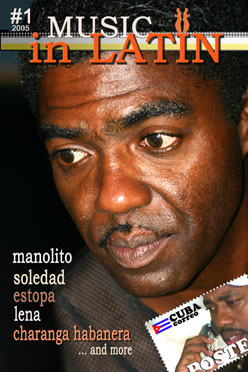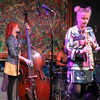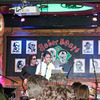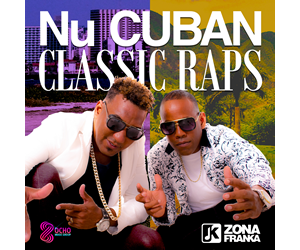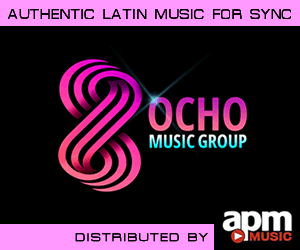Lo Nuevo[hide]
Reportes: From The St... : Jazz Plaza ...
Fotos: Tom Ehrlich : Irakere 50th Annivers...
Fotos: Tom Ehrlich : Irakere
Resenas: Joey Altruda Presents: El Gran ...
Reportes: From The St... : Cubadisco 2...
Timbapedia: 09. Interviews -... : Carlos del Pino ...
Fotos: Tom Ehrlich : 2023 Monterey Jazz Fe...
Fotos: Tom Ehrlich : 2023 Monterey Jazz Fe...
Fotos: Tom Ehrlich : 2023 Monterey Jazz Fe...
Fotos: Tom Ehrlich : 2023 Monterey Jazz Fe...
Grupos: Tirso Duarte
Grupos: Tirso Duarte : Discography
Grupos: Charanga Habaner... : 8. El bla bla bla
Grupos: Pupy y los que S... : Tirso Duarte
Fotos Del Día [hide]
Entrevista - Manolito Simonet - Havana - Aug. 2005
by Artem Ivantsov, Ukraine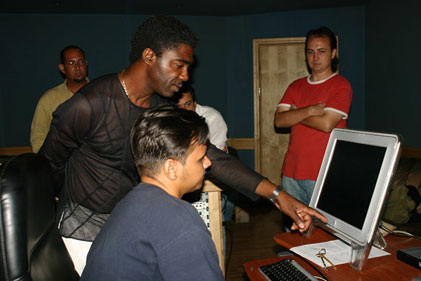
- In our part of the world many don’t know who Manolito is, what his group is, and what style he plays.
- “Manolito y su Trabuco” is an orchestra born in 1993 here, in Habana. The orchestra consists of the musicians from all over the country – from Tuna, from Camaguey (I’m from Camaguey myself), from Pinar del Rio, from Habana itself. So, it’s a mix of musicians. As to the format of our music, we call it “trabuco”. It’s also a mixture. Mixture of “orchestra charanga” with the music of 40-50s. This mixture is exactly where we look for our unique sound. The orchestra already has enjoyed quite an experience of international tours. Beginning from 1995 we have been touring in Western and Northern Europe, USA, Bahamas, Mexico, Peru, Colombia. We’ve been to Japan as well.
- More and more often the word “timba” can be heard in the world today. Do you play timba? What kind of the style is it?
- For me timba is only one of the many styles of Cuban music, such as chachacha, danzon, bolero. Any group may have in its repertoire themes in timba. But it also may have themes in other styles that represent the Cuban popular music. In particular, what bothers us to say that we play only timba is the fact that we play also the music of other countries – vallenata, cumbia. I think that the format named “timba” does not exist. The genre – yes, but not format (Manolito uses here the word “formato” – AI).
- You do cooperate with non-Cuban musicians, don’t you?
- Yes, we have worked with Mark Quinones (we did not record anything, but he likes the orchestra very much), with Canario, with Colombian musicians – Juan Carlos Coronel, Diomedes Diaz. Everybody whom we have encountered in various periods has affected our music. All of them have left something in our art. Among my friends there are Gilberto Santa Rosa, Papo Luca, Cheo Feliciano, Grupo Niche, Grupo Guayuacan, Victor Manuel who sings my songs. With one of them – “El aguila” – he won a grand prix at the festival in New York in 1999.
- There is a Colombian vallenata “Maria Luisa” on Your album “Marcando la distancia”. Isn’t it Carlos Vives? The voice sounds quite alike.
- No, this is Rosendo Diaz, one of our ex-vocalists. We have started working with vallenatas in “Contra todos los pronosticos” where we recorded a classical vallenata “La parranda”. And in our next album we have decided to modernize vallenata a-la Carlos Vives.
- Camaguey has produced many outstanding musicians. Is it a special city?
- The phenomenon of Cuba is in that each province has its unique peculiarities. The basis is a traditional trova. The trova of Camaguey differs from the spiritual trova of Santiago which, in its turn, differs from the trova of Habana. The same refers to Cuban son interpreted by different provinces. The distinctiveness of my music which comes from Camagueyan son is in its combination with the music of Habana. Which results in the music you call “timba”, new-style music.
- Can you describe it with one word?
- Usually it’s Cuban son. But here I must repeat everything I told about timba. Son is only one of the many genres of Cuban music that managed to be the farthest to advance on international markets. I would better call it “Cuban Popular Music” with the further sub-division into chachacha, mambo, son, danzon, etc.
- What has been going on with Cuban music lately?
- The development of the Cuban music in the last years has been having a polemic nature. Being able to obtain an excellent musical education we do not enjoy those opportunities that other Latin musicians do. The TV programs dedicated to Latin music broadcast mainly Thalia, Shakira and the like. This is a wonderful music, but Cuban musicians (from Cuba) do not have such an access. It does not allow us to develop. Each year the musical institutes produce hundreds of wonderful musicians for various styles – in Cuba we play everything: rock, rap, jazz, etc. And virtually the only way to spread our music worldwide is through the enthusiasts like you, who are interested in Cuba and ready to promote the Cuban music on your own.
- Since recently the countries of Latin America, including Cuba, have been overwhelmed with reggaeton. Do You like it?
- The reggaeton is liked by the youngsters. While I am a musician. For me reggaeton is too monotonous. You have listened to 4 tunes and you are fed up. But it has a rich dancing rhythm that thrills the people. Every year the similar things happen – the new wave comes, and everybody talks about it. Today this role is played by reggaeton.
- Will it pass quickly?
- Bueno… Better if it would, but if the people like it…
- What are the impressions from the tours abroad?
- In Europe we cooperate with the company named EUROTROPICAL who are excellent professionals. Thanks to them we are considered a very good orchestra there and always count on the maximum of spectators. The people know all the albums, all the themes, buy our albums. The same happens in New York and Miami, where we toured too. The people know our music very well.
Several years ago we even gave a concert for the prince of Netherlands. It took place in the palace and was very extraordinary for us since our music is danceable. But they knew our songs too! It proves that the music of Trabuco has been spread all over the planet already.
- Seems like the music of Trabuco, as well as the music of other interpreters of the modern son, is difficult to value without knowing how to dance. Is it so?
- Probably yes, because our music is extremely danceable. Although I know a lot of people, first of all children, who don’t attend dances but nevertheless know our music very well and love it. Our music is as well for those who like just to listen.
- Which your album is the most valuable for you?
- Each of them has something that I value. But the album that brought us to the international orbit, that “marked the distance” is called “Marcando la distancia”.
- In Europe, in particular, in Ukraine and Russia, your aficionados have got an album called “Manolito Light”. Tell us about this story.
- Such an album does not exist. There was a concert dedicated to one of the best Cuban radio stations “Frecuencia Total”. Its tenth anniversary gathered such stars as Candido Fabres, Manuel Denis, Rojitas among the others. My orchestra accompanied those singers. We had only three days for preparation. The concert took place in Teatro Nacional. One of the songs, for example, was supposed to be sung by Candido Fabres. But he did not manage to return in time from the East, and so it went without vocal. All that was not supposed to be taken outside the walls of the theatre, but somehow it did, and so-called “Manolito Light” soon was all over the Europe. I would like to use this opportunity to declare that this disc is not an album of “Manolito y su Trabuco”. It’s a record of the concert dedicated to the famous radio station.
- Now, when it’s clear with “Manolito Light” we would like to hear about the truly new Manolito’s album.
- We are finishing the production of the new album called “Hablando en serio”. I will be mastering it in Tenerife in the mid-August. So, in September it should be on sale already. I recommend it to you. We have gathered in it all the genres with which we worked in previous albums. The disc is very danceable, very “arriba” (shows how “arriba” it is”). It’s more “arriba” than “Locos por mi Habana” which has been also very popular among the fans.
- What new names we are about to hear in the nearest future?
- Even don’t know… New works emerge constantly. Maybe Boni, ex-vocalist of Charanga Habanera, his new album is very good. There are many good works in other styles. For example, in rap. There is a very good rock-group from Pinar del Rio. Group “Tendencia”. We have a lot of great music. Ah! Of course, X Alfonso (Equis Alfonso). If You’ve got time to meet with him, don’t loose this opportunity. He is one of the greatest representatives of the new generation of Cuban music, son of Alfonso, director of “Sintesis”. He plays piano, does all arrangements, has made himself a video clip on the highest international level. Awarded with CUBADISCO. Very, very high level indeed.
- Many thanks to You, Manolito, for this interview. We are waiting for You in our part of the world where You already have a lot of aficionados
- For me would be an honor to visit your countries where, as I know, the Cuban music has always been very popular, and where the relations with Cuba has always been strong. So, You may count on me. Just say, and we’ll come to give you concerts.
